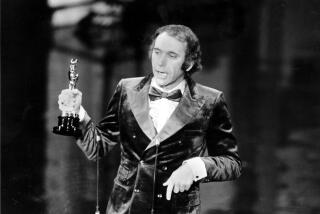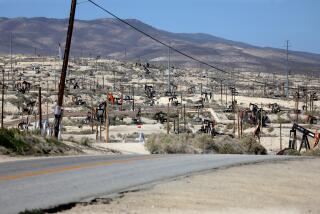Robert Woodruff, Builder of Coca-Cola Empire, Dies
- Share via
ATLANTA — Robert W. Woodruff, a reclusive Georgian who rescued the Coca-Cola Co. from threatened bankruptcy in the 1920s and built it into one of the world’s great business empires, died Thursday. He was 95.
Woodruff, who had been in failing health since suffering two strokes in 1972, died after a 10-day stay at Emory University Hospital. He was credited with being the person most responsible for Coca-Cola becoming perhaps the world’s best known American product.
Philanthropist, confidant of Presidents, bon vivant, avid hunter and outdoorsman, gifted salesman and reportedly the richest man in the South, Woodruff was a legend in U.S. business circles for more than half a century.
Yet, to the general public, he was one of the least known of the nation’s major business figures. This was of his own choosing. He had a passion for anonymity and once paid a press agent to keep his name out of the newspapers.
“He ran his organization with a velvet gauntlet,” said Charles Elliot, a friend and hunting companion. “Few major decisions were made without his approval.”
Although Woodruff, who became president of Coca-Cola in 1923, retired as an officer of the firm in 1955, he was the company’s largest single stockholder and remained its dominant force until his death.
He retired from the board last year. Until then, he had continued to handpick the company’s presidents and board chairmen.
Woodruff also was a man of national influence. With one exception, he knew and sometimes advised and assisted every President from Herbert Hoover through fellow Georgian Jimmy Carter.
The exception was Richard M. Nixon, who had close ties with Donald M. Kendall, head of Woodruff’s arch-rival, Pepsi-Cola.
Of all the Presidents he knew, Woodruff was closest to Dwight D. Eisenhower, who gave him White House pass No. 1. The two men became friends during World War II, and Woodruff, although a staunch Democrat, was an enthusiastic backer of Eisenhower for the presidency.
Dominant Figure
For decades, Woodruff was as dominant a figure in Atlanta as he was with Coca-Cola.
In the 1960s, when turtleneck shirts came into fashion, members of Atlanta’s exclusive Commerce Club met to decide whether the club’s coat-and-tie rule should be amended to sanction turtlenecks.
The head of the city’s largest department store made a motion to that effect, and it passed unanimously.
Woodruff, who was hard of hearing, turned his good ear to then-Mayor Ivan Allen Jr., who was presiding, and asked what was going on.
“Turtleneck shirts,” the mayor explained.
Motion Withdrawn
“Don’t like ‘em,” Woodruff said with a frown. The motion was promptly withdrawn.
Allen’s predecessor, the late William B. Hartsfield, who was mayor of Atlanta from 1937 to 1962, once said: “I have never taken an action as mayor but what I would consider the effect of any national publicity on the Coca-Cola Co. and my good friend Bob Woodruff.”
Woodruff was a progressive on racial matters. When Mayor Allen was invited to testify before Congress in favor of the 1964 Civil Rights Act bill, he consulted Woodruff beforehand.
“Mr. Woodruff told him he didn’t have any choice about it, that he should do it,” Joseph M. Jones, Coca-Cola’s senior vice president and Woodruff’s personal secretary, recalled in a 1982 interview with The Times.
Division Over King
“Then there was the time the Rev. Martin Luther King Jr. received the Nobel Peace Prize,” Jones said. “There was some division in the community whether he should be honored. Here again, Mr. Woodruff, through former Mayor Hartsfield, said: ‘Don’t be absurd; of course he was to be honored,’ and he was.”
Woodruff’s dominant interest in life, aside from a zest for hunting and fishing and golf, was Coca-Cola. Yet it was an association that began accidentally because of his family.
Robert Winship Woodruff was born in Columbus, Ga., on Dec. 6, 1889. His forbears on both his father’s and mother’s side had migrated from New England to Georgia before the Civil War and became millionaires.
Woodruff’s father, Ernest, moved to Atlanta in 1893, where he became president of the Trust Co. of Georgia. In 1919, 28 years after Asa Candler bought the secret formula for Coca-Cola from its originator, Dr. John S. Pemberton, for $2,300, a banking syndicate headed by Ernest Woodruff purchased the Coca-Cola Co. for $25 million.
Fell on Bad Times
The new company fell on bad times and went heavily into debt. In desperation, the directors appealed to Robert Woodruff to take over the presidency of the firm, the main sales of which were at soda fountains at the time.
Young Woodruff was reluctant. His relations with his father were strained. He had barely managed to get a high school diploma at the Georgia Military Academy, and he had left Emory College (later Emory University) out of the boredom after one quarter.
Books did not interest him. He wanted to be a big game guide out West or to be a salesman and make a million dollars. He chose the latter. After various jobs he joined the old White Motor Co., selling trucks and cars.
His rise was meteoric. By 1923, at age 33, he was vice president and general sales manager of White, living in Cleveland, making $85,000 a year.
Agreed to Salary Cut
But he had invested heavily in Coca-Cola stock and, anxious to recoup his losses because of a sharp drop in Coke stock, he agreed to take over the ailing company at a salary cut of $50,000 a year.
Through his selling and managerial talents, he paid off all of Coca-Cola’s debts within four years, including a $22-million mortgage held by the Guarantee Trust Co. of New York. The bank, in turn, handed back the secret formula for Coke it had held as collateral.
To the despair of soft drink rivals, who have tried in vain to analyze the exact components and their proportions, the Coke formula remains one of the world’s great secrets.
“There is only one component that is secret,” Coca Cola’s Jones said, adding that only one person in the entire company knows the exact formula at any one time.
Sold to Servicemen
One of Woodruff’s greatest coups came at the outset of World War II, when he decided to make Coke available to all U.S. servicemen everywhere for a nickel, at which it was then selling, despite the added distribution costs.
The move was as shrewd as it was patriotic. Sugar, rationed at home, was made available in unlimited supplies for Coke to be sent to the troops. The government, in addition to paying for transportation of Coke, also shipped parts for bottling plants to be set up in war zones.
Sixty-four plants were built overseas, and 5 billion bottles of Coke were consumed during the war, creating a vast new number of consumers both among the troops and civilians in countries where they had been stationed.
Today, Coke is bottled and sold in nearly every country.
Shunned Publicity
In 1950, Woodruff refused to let his picture appear on the cover of Time magazine to accompany a story about Coca-Cola. Until he was in his 80s, Woodruff’s abhorrence of publicity extended even to his vast philanthropic donations. His gifts to various educational, scientific and civic causes have been estimated at more than $400 million.
Woodruff died childless. His wife, Nell Kendall Hodgson, whom he married in 1912, died in 1968 and he never remarried.
More to Read
Inside the business of entertainment
The Wide Shot brings you news, analysis and insights on everything from streaming wars to production — and what it all means for the future.
You may occasionally receive promotional content from the Los Angeles Times.










